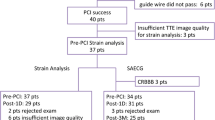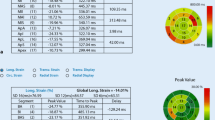Abstract
External Counterpulsation (ECP) is one of the therapeutic options in patients with refractory angina inadequately controlled by medical, interventional, or surgical therapy. The 2D Speckle Tracking Echocardiography (2D-STE) method is considered superior in assessing clinical improvement. We would like to evaluate any improvement of myocardial intrinsic function using 2D-STE in patients underwent standard ECP protocol (35 sessions). We conducted a double-blind randomized controlled trial. Patients with refractory angina who could not be revascularized conventionally were randomized into two groups: (1) the ECP group (300 mmHg) and (2) the Sham/control group (75 mmHg). ECP standard therapy was given for 35 sessions (1 h/day/session). The 2D-STE data, including longitudinal strain and post systolic index (PSI) were obtained before and after therapy. 43 subjects were analyzed, with 22 subjects in ECP group and 21 control subjects (Sham group). A homogenous baseline strain was found either globally (12.42 ± 4.55 vs 12.00 ± 4.92 [− %]; P = 0.774) or segmentally/regionally (12.63 (0.01–25.16) vs 12.43 (0.01–27.20) [− %]; P = 0.570). There was no statistically significant improvement between groups in the left ventricle longitudinal strain globally (P = 0.535) and segmentally/regionally (P = 0.434). PSI parameters showed improvement in the ECP group (P = 0.049), and segments with PSI ≥ 20% seemed to improve longitudinal strains in the ECP group after therapy (P = 0.042). In conclusion, 35 ECP therapy sessions did not improve either global or segmental/regional left ventricular mechanical function in patients with refractory angina. However, the mechanical function of myocardial segments with PSS tends to improve after ECP therapy.


Similar content being viewed by others
Abbreviations
- 2D-STE:
-
2-Dimensional Speckle-Tracking Echocardiography
- AVC:
-
Aortic Valve Closure
- CAD:
-
Coronary Artery Disease
- CABG:
-
Coronary Artery Bypass Graft
- CCS:
-
Canadian Cardiovascular Society
- D/S ratio:
-
Diastolic/Systolic Peak Ratio
- CAD3VD:
-
Coronary Artery Disease 3 Vessels Disease
- ECP:
-
External Counterpulsation
- EDD:
-
End-Diastolic Diameter
- ESD:
-
Left Ventricle End-Systolic Diameter
- LAD:
-
Left Anterior Descending
- LM:
-
Left Main
- LV:
-
Left Ventricular
- LVEF:
-
Left Ventricular Ejection Fraction
- PCI:
-
Percutaneous coronary intervention
- PSI:
-
Post-systolic Index
- PSS:
-
Post-systolic Shortening
- SPECT:
-
Single-Photon Emission Computed Tomography
- TAPSE:
-
Tricuspid Annular Plane Systolic Excursion
References
Mannheimer C (2002) The problem of chronic refractory angina. Report from the ESC Joint Study Group on the Treatment of Refractory Angina. Eur Heart J 23:355–370. https://doi.org/10.1053/euhj.2001.2706
Force T, Gilles M, Chairperson M et al (2013) 2013 ESC guidelines on the management of stable coronary artery disease. Eur Heart J 34:2949–3003. https://doi.org/10.1093/eurheartj/eht296
Williams B, Menon M, Satran D et al (2010) Original studies patients with coronary artery disease not amenable to traditional revascularization: prevalence and 3-year mortality. Cathet Cardiovasc Intervent 891:886–891. https://doi.org/10.1002/ccd.22431
Knuuti J, Wijns W, Saraste A et al (2020) 2019 ESC Guidelines for the diagnosis and management of chronic coronary syndromes. Eur Heart J 41:407–477. https://doi.org/10.1093/eurheartj/ehz425
Feldman A (2002) Enhanced external counterpulsation: mechanism of action. Clin Cardiol 25:II-11-II–15. https://doi.org/10.1097/MD.0000000000002002
Stys TP, Lawson WE, Hui JC et al (2002) Effects of enhanced external counterpulsation on stress radionuclide coronary perfusion and exercise capacity in chronic stable angina pectoris. Am J Cardiol 89:822–824. https://doi.org/10.1016/S0002-9149(02)02191-4
Karim S, Sani A, Karo-karo S et al (1995) Asian cardiovascular and thoracic annals. Asian Cardiovasc Thorac Ann 3:26–28. https://doi.org/10.1177/021849239500300108
Michaels AD, Raisinghani A, Soran O et al (2005) The effects of enhanced external counterpulsation on myocardial perfusion in patients with stable angina: a multicenter radionuclide study. Am Heart J 150:1066–1073. https://doi.org/10.1016/j.ahj.2005.01.054
Estahbanathy G, Samiei N, Maleki M et al (2007) 547 Echocardiographic characteristics including tissue Doppler imaging after enhanced external counterpulsation therapy. Eur J Hear Fail Suppl 6:125–126. https://doi.org/10.1016/S1567-4215(07)60352-X
Wang P, Liu Y, Ren L (2019) Evaluation of left ventricular function after percutaneous recanalization of chronic coronary occlusions. Herz 44:170–174. https://doi.org/10.1007/s00059-017-4663-1
Lyseggen E, Skulstad H, Helle-Valle T et al (2005) Myocardial strain analysis in acute coronary occlusion. Circulation 112:3901–3910. https://doi.org/10.1161/CIRCULATIONAHA.105.533372
Mor-Avi V, Lang RM, Badano LP et al (2011) Current and evolving echocardiographic techniques for the quantitative evaluation of cardiac mechanics: ASE/EAE consensus statement on methodology and indications endorsed by the Japanese Society of Echocardiography. Eur J Echocardiogr 12:167–205. https://doi.org/10.1093/ejechocard/jer021
Eftekhari A, May O (2012) The immediate hemodynamic effects of enhanced external counterpulsation on the left ventricular function. Scand Cardiovasc J 46:81–86. https://doi.org/10.3109/14017431.2012.654814
Brainin P, Biering-Sørensen SR, Møgelvang R et al (2018) Postsystolic shortening by speckle tracking echocardiography is an independent predictor of cardiovascular events and mortality in the general population. J Am Heart Assoc 7:1–11. https://doi.org/10.1161/JAHA.117.008367
Romano S, Mansour IN, Kansal M et al (2017) Left Ventricular global longitudinal strain predicts heart failure readmission in acute decompensated heart failure. Cardiovasc Ultrasound 15:1–6. https://doi.org/10.1186/s12947-017-0098-3
Esmaeilzadeh M, Khaledifar A, Maleki M et al (2009) Evaluation of left ventricular systolic and diastolic regional function after enhanced external counter pulsation therapy using strain rate imaging. Eur J Echocardiogr 8:120–126. https://doi.org/10.1093/ejechocard/jen183
Sastroasmoro S (2014) Dasar-dasar Metodologi Penelitian Klinis, 5th edn. Sagung Seto, Jakarta
Biering-Sørensen T, Biering-Sørensen SR, Olsen FJ et al (2017) Global longitudinal strain by echocardiography predicts long-term risk of cardiovascular morbidity and mortality in a low-risk general population: the Copenhagen City heart study. Circ Cardiovasc Imaging 10:1–11. https://doi.org/10.1161/CIRCIMAGING.116.005521
Broughton KM, Wang BJ, Firouzi F et al (2018) Mechanisms of cardiac repair and regeneration. Circ Res 122:1151–1163. https://doi.org/10.1161/CIRCRESAHA.117.312586
Brainin P, Hoffmann S, Fritz-Hansen T et al (2018) Usefulness of postsystolic shortening to diagnose coronary artery disease and predict future cardiovascular events in stable angina pectoris. J Am Soc Echocardiogr 31:870-879.e3. https://doi.org/10.1016/j.echo.2018.05.007
Funding
This study was funded by a Riset Unggulan Harapan Kita award, a program to support clinical research by National Cardiovascular Center Harapan Kita.
Author information
Authors and Affiliations
Corresponding author
Ethics declarations
Conflict of interest
Ade M Ambari, MD, received an ECP device for this study from SimaxMed®. The funders had no role in the study’s design, the collection, analysis, or interpretation of data, the report’s writing, or the decision to submit the article for publication.
Ethical approval
All procedures performed in studies involving human participants conform to the institutional and/or national research committee’s ethical standards and with the 1964 Helsinki declaration and its later amendments or comparable ethical standards as reflected in a priori approval by the National Cardiovascular Center Harapan Kita Institutional Review Board.
Informed consent
Informed consent was obtained from all individual participants included in the study.
Additional information
Publisher's Note
Springer Nature remains neutral with regard to jurisdictional claims in published maps and institutional affiliations.
Supplementary Information
Below is the link to the electronic supplementary material.
Rights and permissions
About this article
Cite this article
Pravian, D., Soesanto, A.M., Ambari, A.M. et al. The effect of external counterpulsation on intrinsic myocardial function evaluated by speckle tracking echocardiography in refractory angina patients: a randomized controlled trial. Int J Cardiovasc Imaging 37, 2483–2490 (2021). https://doi.org/10.1007/s10554-021-02289-x
Received:
Accepted:
Published:
Issue Date:
DOI: https://doi.org/10.1007/s10554-021-02289-x




